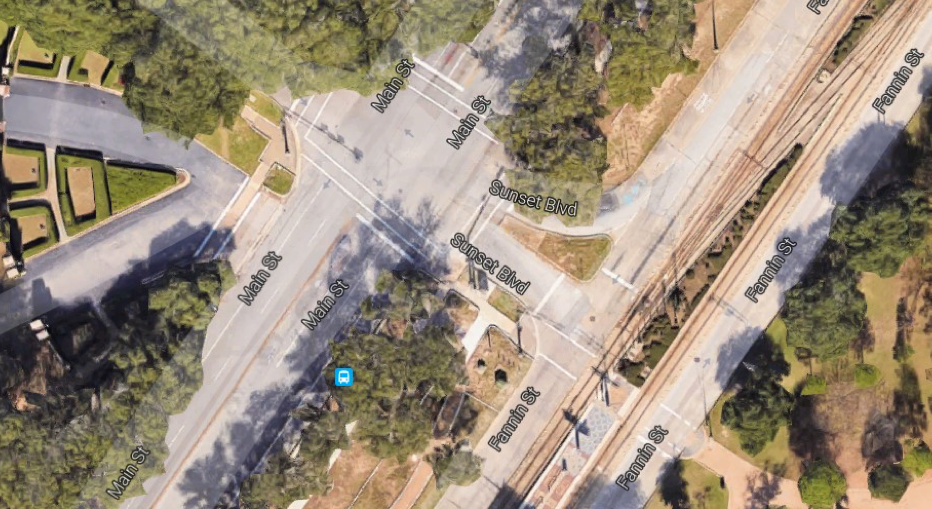When Rice University Professor Marjorie Corcoran was fatally struck by a light-rail train earlier this year, those who care about the city’s transportation networks turned their collective attention toward increasing safety at the intersection where the crash occurred.
Corcoran was struck at the corner of Fannin Street and the Hermann Park bike path. When joined with the nearby Sunset Boulevard and Main Street intersection, this crossing is one of central Houston’s most complicated and potentially dangerous.
METRO, the city’s public works department and partners like Bike Houston quickly worked together to try to increase safety along the rail line for all users. They, along with other stakeholders, sought to understand lessons that might be drawn from the tragedy.
A Google Maps view of the intersection shows just how complicated it is. Corcoran was struck near the lower right corner of this image where the path crosses the light rail tracks. One set of pedestrian signals gets people from the park across four lanes of traffic and the rail tracks, to the Main Street side of Fannin Street. Another set directs them across the six lanes of Main Street, and these signals are not coordinated. There are two separate traffic lights—one set at Main Street and Sunset Boulevard and another at Fannin Street and Sunset Boulevard.
Complicating matters further, there is an entrance to Rice University almost on top of the northwestern corner of Main and Sunset. While this intersection is heavily used by people on bikes and pedestrians going to and from the park and the light-rail station, it is clearly a space designed heavily to prioritize automobile traffic.
After her death, crosswalks on the light rail side were painted bright red; additional signs were installed that warn pedestrians, people on bikes, and drivers of greater safety risks; and METRO added more distinctive markers and required additional horn blasts from its trains to get people’s attention at intersections.
These moves were all important, but they were also reactive. One of the challenges of achieving road safety for all road users is finding ways to identify areas of increased risk before tragedies like the one that befell Corcoran take place. We don’t have enough police officers to enforce speed limits on every road nor enough infrastructure money to make every street and intersection comfortable for every user. But if we can identify places where dangerous crashes might occur through predictive research we might be able to make existing resources go further and possibly work to reduce the number of fatalities and injuries on our roads.
The Kinder Institute’s Dangerous Crossings: The Relationship between Intersections and Crashes in Houston attempts to do just that by exploring the relationship between car and pedestrian/bicyclist crashes and street intersections. Using a technique called “colocation,” this report examined all crashes between 2010-2016 that occurred in or near intersections in the city of Houston with certain control characteristics—traffic light-controlled, stop sign-controlled, and non-stop sign controlled.
On the whole, the Kinder Institute found, traffic light-controlled intersections are far more likely to attract future crash incidents than either intersections with stop signs or intersections that lack both stop signs or stoplights.
Much of this has to do with speed of travel, increased opportunities for crashes to occur on busier streets, and the complications of major intersections. In other words, the busiest streets wit the fastest traffic also tend to be the ones that have stoplights.
This finding isn’t likely to be a surprise to traffic engineers or police officers, who know the danger of these intersections. For everyday citizens, though, stoplight intersections are usually seen as safe, controlled areas. Our findings suggest, though, that these intersections need to continue to be the focus of safety efforts—whether it’s by slowing traffic through enforcement or continued efforts to create a street design that caters to the safety of all users, not just drivers.

